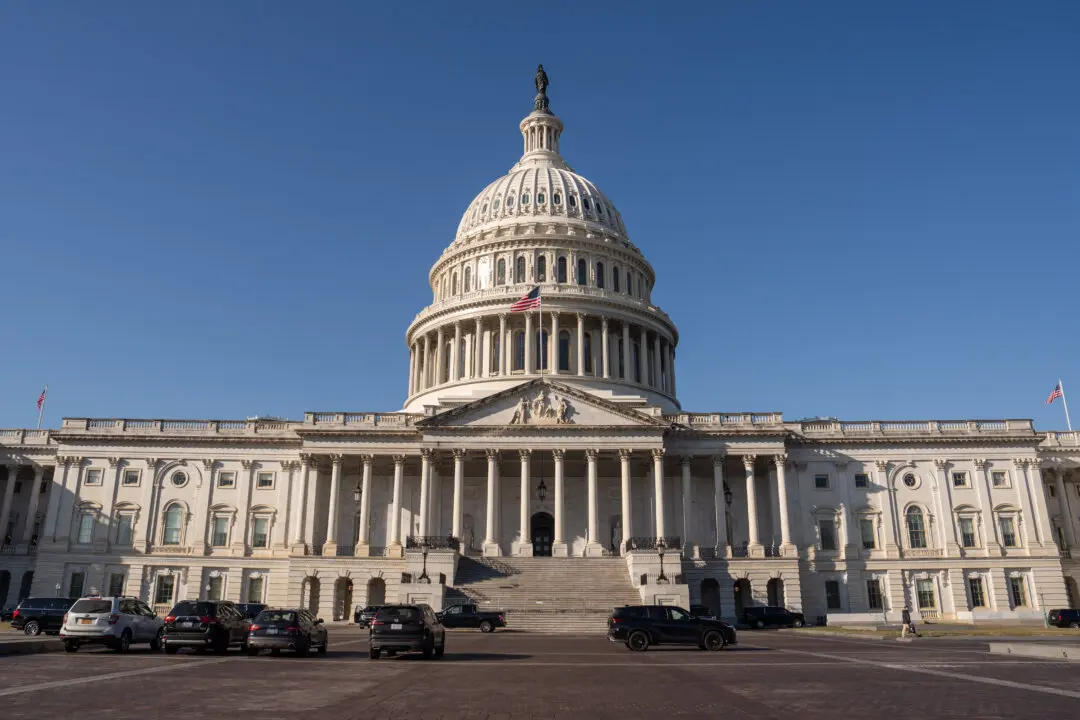When Maryland Gov. Larry Hogan, a Republican, signed into law new congressional maps drawn by the Democrat-controlled state General Assembly on April 4, Maryland became the 47th state to formally adopt new legislative and congressional districts following the 2020 U.S. Census.
With Louisiana’s Republican-led legislature on March 30 overriding Democratic Gov. John Bel Edwards’s rejection of its adopted district maps, the only states without new legislative and congressional districts in place for 2022 elections as of April 5 were Florida, New Hampshire, and Missouri.
In fact, 397 of the nation’s 435 congressional districts—or 91.26 percent—have been redrafted, approved, and put into effect across 47 states in time for the 2022 primaries, which are already underway in several states.
In addition to congressional district reapportionment, the decennial post-Census redistricting effort also encompasses the 7,383 seats in all 50 state legislatures. Redistricting there remains incomplete or legally challenged in at least four states: Alaska, Ohio, Missouri, and Wisconsin.
Pending legal action could still marginally amend adopted legislative district maps in several states, most notably in New York, Maryland, and Ohio.
But beyond the 38 congressional seats that are representing Florida, New Hampshire, and Missouri, more than 91 percent of the nation’s congressional districts are mapped and in place for the next decade.
Unresolved Map Disputes
Hogan signed Maryland’s new legislative maps into law after lawmakers dropped their appeal of Anne Arundel Circuit Court Judge Lynne Battaglia’s March 25 rejection of maps drawn by the Democrat-controlled General Assembly.
Legal challenges to the maps had already prompted the state to push its primary back from June 28 to July 19.
Battaglia ordered the General Assembly to redraw the map by March 30. In response, the assembly submitted what are essentially 2010 maps for the 2022 election cycle—which Hogan signed—while also saying that they would appeal the March 25 ruling.
The maps’ status was cemented into 2020 stasis a few hours after Hogan signed them when a special magistrate adviser to the state’s Court of Appeals system recommended that the Maryland Supreme Court reject four petitions contending that the General Assembly’s maps violated a state constitutional requirement that legislative districts “be compact and respect natural and political boundaries.”
Special Magistrate Alan Wilner determined in his advisory that the legislative map should stand, but the Maryland Supreme Court will hear his report on April 13.
Congressional maps adopted in North Carolina, Ohio, Georgia, Wisconsin, and Pennsylvania by Republicans and in Minnesota by Democrats have been struck down by court rulings and supplanted with “less biased” maps that have been subsequently adopted for 2022 campaigns, but are likely to be re-legislated or re-litigated before the 2024 elections.
Lawsuits alleging that new districts drawn in Arkansas, South Carolina, and Texas unlawfully dilute minority voter influence are also unlikely to be resolved until after the 2022 election cycle.
Florida, with 28 congressional districts, is the most politically significant state without adopted legislative district maps.
New Hampshire has two congressional districts and Missouri eight. Missouri lawmakers are the nation’s only state legislators who have failed to approve redistricted legislative maps in the wake of the 2020 Census.
Florida: Republican Gov. Ron DeSantis vetoed on March 29 congressional maps drawn by the Republican-controlled state legislature and has called lawmakers to Tallahassee for an April 19 to April 22 special session to deliberate on the competing maps.
The state’s population growth means that it has added a 28th congressional seat. In divvying up the 27 existing districts into 28, DeSantis’s proposed map seeks to give Republicans a greater advantage than the legislature’s maps do.
Much of the contention between Florida Republican leaders relates to House District 5 in the Tallahassee area—the only Democrat-controlled statehouse district north of Tallahassee—that DeSantis wants diminished to a greater degree than the legislature’s plan does.
Common Cause Florida, FairDistricts Now, and five individuals filed a lawsuit on March 11 against the legislature in U.S. District Court in Tallahassee, claiming that the intra-party impasse between DeSantis and lawmakers was impeding fair access to the polls for state voters and that the maps were gerrymandered. The lawsuit petitions the court to step in and draw the boundaries.
On April 1, Florida Secretary of State Laurel Lee asked to stay the federal lawsuit until after lawmakers conclude their April 19 special session. The court is expected to issue a ruling regarding a stay by April 11.
New Hampshire: Republican Gov. Chris Sununu said he'll veto a congressional map adopted by New Hampshire’s Republican-led legislature and on March 22 submitted his own plan to lawmakers that would make the state’s two congressional districts more competitive.
On March 31, five New Hampshire voters filed a lawsuit challenging the legislature’s and Sununu’s congressional district maps and asked a county superior court to draw the voting districts before the state’s Sept. 3 primaries.
Missouri: The only state where new congressional maps haven’t been passed by the legislature. Missouri House and Senate Republicans can’t agree on how to divvy up the eight congressional districts.
The Missouri House has rejected congressional maps adopted on March 24 by the Missouri Senate. The upper chamber had previously tossed the proposed maps approved by the House in January.
Because the candidate filing deadline for the state’s Aug. 2 primary was March 29, hopefuls for 2022 elections were allowed to proceed using 2010 boundaries. However, a lawsuit has been filed, as congressional districts are required to have equal populations based on the most recent Census.
A March 11 lawsuit filed in Cole County Circuit Court by five voters from “over-populated districts” contends that it’s unconstitutional to use the 2010 maps for the 2022 election because of population shifts.





